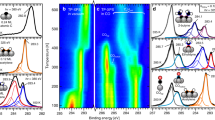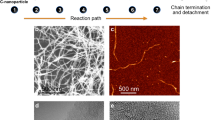Abstract
Fischer–Tropsch synthesis is a heterogeneous catalytic reaction that creates approximately 2% of the world's fuel. It involves the synthesis of linear hydrocarbon molecules from a gaseous mixture of carbon monoxide and hydrogen at high pressures (from a few to tens of bars) and high temperatures (200–350 °C). To gain further insight into the fundamental mechanisms of this industrial process, we have used a purpose-built scanning tunnelling microscope to monitor a cobalt model catalyst under reaction conditions. We show that, after 30 minutes of reaction, the terraces of the cobalt catalyst are covered by parallel arrays of stripes. We propose that the stripes are formed by the self-assembly of linear hydrocarbon product molecules. Surprisingly, the width of the stripes corresponds to molecules that are 14 or 15 carbon atoms long. We introduce a simple model that explains the accumulation of such long molecules by describing their monomer-by-monomer synthesis and explicitly accounting for their thermal desorption.
This is a preview of subscription content, access via your institution
Access options
Subscribe to this journal
Receive 12 print issues and online access
$259.00 per year
only $21.58 per issue
Buy this article
- Purchase on Springer Link
- Instant access to full article PDF
Prices may be subject to local taxes which are calculated during checkout





Similar content being viewed by others
References
Van der Laan, G. P. & Beenacker, A. A. C. M. Kinetics and selectivity of the Fischer–Tropsch synthesis: a literature review. Catal. Rev. Sci. Eng. 41, 255–318 (1999).
Chaumette, P., Courty, Ph., Kiennemann, A. & Ernst, B. Higher alcohol and paraffin synthesis on cobalt based catalysts: comparison of mechanistic aspects. Top. Catal. 2, 117–126 (1995).
Anderson, R. B. The Fischer–Tropsch Synthesis (Academic, 1984).
Fischer, F. & Tropsch, H. Uber reduktion und hydrierung des Kohlenoxyds. Brennst. Chem. 7, 97 (1926).
Geerlings, I. J. C., Zonnevylle, M. C. & Groot, C. P. M. The Fischer–Tropsch reaction on a cobalt (0001) single crystal. Catal. Lett. 5, 309–314 (1990).
Beitel, G. A., de Groot, C. P. M., Oosterbeek, H. & Wilson, J. H. A combined in-situ PM-RAIRS and kinetic study of single-crystal cobalt catalysts under synthesis gas at pressures up to 300 mbar. J. Phys. Chem. B 101, 4035–4043 (1997).
Oosterbeek, H. Bridging the pressure and material gap in heterogeneous catalysis: cobalt Fischer–Tropsch catalysts from surface science to industrial application. Phys. Chem. Chem. Phys. 9, 3570–3576 (2007).
Friedel, R. A. & Anderson, R. B. Composition of synthetic liquid fuels. I. Product distribution and analysis of C5-C8 paraffin isomers from cobalt catalyst. J. Am. Chem. Soc. 72, 1212–1215 (1950).
Schulz, G. V. Uber die Bezeihung zwischen Reaktionsgeschwindigkeit und Zusammensetzung des Reaktionsproduktes bei Macropolymerisationsvorgangen. Z. Phys. Chem. B30, 379 (1935).
Flory, P. J. Molecular size distribution in linear condensation polymers. J. Am. Chem. Soc. 58, 1877–1885 (1936).
Anderson, R. B., Seligman, B., Shultz, J. F., Kelly, R. & Elliott, M. A. Fischer–Tropsch synthesis. Some important variables of the synthesis on iron catalyst. Ind. Eng. Chem. 44, 391–397 (1952).
Schulz, H. Major and minor reactions in Fischer–Tropsch synthesis on cobalt catalysts. Top. Catal. 26, 1–4 (2003).
Herbschleb, C. C. T. et al. The reactorSTM: atomically resolved scanning tunneling microscopy under high-pressure, high-temperature catalytic reaction conditions. Rev. Sci. Instrum. 85, 083703 (2014).
Horcas, I. et al. WSXM: a software for scanning probe microscopy and a tool for nanotechnology. Rev. Sci. Instrum. 78, 013705 (2014).
Bartels, L., Meyer, G. & Rieder, K.-H. Controlled vertical manipulation of single CO molecules with the scanning tunneling microscope: a route to chemical contrast. Appl. Phys. Lett. 71, 213 (1997).
Ehrensperger, M. & Wintterlin, J. In situ high-pressure high-temperature scanning tunneling microscopy of a Co(0001) Fischer–Tropsch model catalyst. J. Catal. 319, 274–282 (2014).
Nakamura, S. Study of metallic carbides by electron diffraction part IV. Cobalt carbides. J. Phys. Soc. Jpn 16, 1213–1219 (1961).
Bergerhoff, G. & Brown, I. D. in International Union of Crystallography (eds Allen, F. H. et al.) 77–95 (Chester, 1987).
Zhao, Y.-H., Su, H.-Y., Sun, K., Liu, J. & Li, W.-X. Structural and electronic properties of cobalt carbide Co2C and its surface stability: density functional theory study. Surf. Sci. 606, 598–604 (2012).
Ehrensperger, M. & Wintterlin, J. In situ scanning tunneling microscopy of the poisoning of a Co(0001) Fischer–Tropsch model catalyst by sulfur. J. Catal. 329, 49–56 (2015).
Knight, C. C. & Somorjai, G. A. Surface science studies of cobalt overlayers on clean and sulfur covered Mo(100) single crystal surfaces. Surf. Sci. 240, 101–111 (1990).
Yamada, R. & Uosaki, K. Two-dimensional crystals of alkanes formed on Au(111) surface in neat liquid: structural investigation by scanning tunneling microscopy. J. Phys. Chem. B 104, 6021–6027 (2000).
Uosaki, K. & Yamada, R. Formation of two-dimensional crystals of alkanes on the Au(111) surface in neat liquid. J. Am. Chem. Soc. 121, 4090–4091 (1999).
Xie, Z. X., Xu, X., Tang, J. & Mao, B. W. Molecular packing in self-assembled monolayers of normal alkane on Au(111) surfaces. Chem. Phys. Lett. 323, 209–216 (2000).
Marchenko, J. & Cousty, A. Substrate-induced freezing of alkane monolayers adsorbed on Au(111) dependent on the alkane/gold misfit. Surf. Sci. 520, 128–136 (2002).
Weaver, J. F., Ikai, M., Carlsson, A. & Madix, R. J. Molecular adsorption and growth of n-butane adlayers on Pt(111). Surf. Sci. 470, 226–242 (2001).
Berner, S. et al. Adsorption and two-dimensional phases of a large polar molecule: sub-phthalocyanine on Ag(111). Phys. Rev. B 68, 115410 (2003).
Fichthorn, K. A. & Miron, R. A. Thermal desorption of large molecules from solid surfaces. Phys. Rev. Lett. 89, 196103 (2002).
Wetterer, S. M., Lavrich, D. J., Cummings, T., Bernasek, S. L. & Scoles, G. Energetics and kinetics of the physisorption of hydrocarbons on Au(111). J. Phys. Chem. B 102, 9266–9275 (1998).
Albers, P., Angert, H., Prescher, G., Seibold, K. & Parker, S. F. Catalyst poisoning by methyl groups. Chem. Commun. 1619–1620 (1999).
Balandin, A. A. Modern state of the multiplet theory of heterogeneous catalysis. Adv. Catal. Rel. Sub. 19, 1–210 (1969).
Cheng, J. & Hu, P. Utilization of the three-dimensional volcano surface to understand the chemistry of multiphase systems in heterogeneous catalysis. J. Am. Chem. Soc. 130, 10868–10869 (2008).
Leendert Bezemer, G. et al. Cobalt particle size effects in the Fischer–Tropsch reaction studied with carbon nanofiber supported catalysts. J. Am. Chem. Soc. 128, 3956–3964 (2006).
Acknowledgements
V.N. acknowledges the Netherlands Organization for Scientific Research (NWO) and the Technology Foundation (STW) for the financial support as part of the research programme Veni (project no. 11920). The authors acknowledge scientific discussions with A.P. van Bavel, H. Oosterbeek and H.P.C.E. Kuipers from Shell Global Solutions International B.V.
Author information
Authors and Affiliations
Contributions
J.W.M.F. and V.N. conceived the experiment, developed the analytical model and wrote the paper. V.N. designed and performed the experiment and analysed the results. M.A.v.S. assisted with experiments and commented on the manuscript.
Corresponding author
Ethics declarations
Competing interests
The authors declare no competing financial interests.
Supplementary information
Supplementary information
Supplementary information (PDF 4521 kb)
Rights and permissions
About this article
Cite this article
Navarro, V., van Spronsen, M. & Frenken, J. In situ observation of self-assembled hydrocarbon Fischer–Tropsch products on a cobalt catalyst. Nature Chem 8, 929–934 (2016). https://doi.org/10.1038/nchem.2613
Received:
Accepted:
Published:
Issue Date:
DOI: https://doi.org/10.1038/nchem.2613
This article is cited by
-
Unraveling surface structures of gallium promoted transition metal catalysts in CO2 hydrogenation
Nature Communications (2023)
-
Metallic Nanoparticles in Heterogeneous Catalysis
Catalysis Letters (2021)
-
Mechanistic insight into carbon-carbon bond formation on cobalt under simulated Fischer-Tropsch synthesis conditions
Nature Communications (2020)
-
Disk-Shaped Cobalt Nanocrystals as Fischer–Tropsch Synthesis Catalysts Under Industrially Relevant Conditions
Topics in Catalysis (2020)
-
Promoted cobalt metal catalysts suitable for the production of lower olefins from natural gas
Nature Communications (2019)



